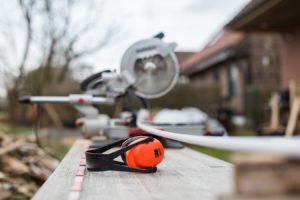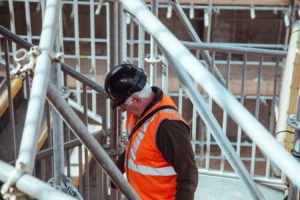5 Actions You Can Take to Maximize On-Site Safety
November 3, 2017, 1:43 PM /
 The most important assets on any jobsite are the people, which is why safety always needs to be an integral part of your day-to-day operations. This is especially the case for anyone involved in the construction industry. Although the sector comprises only about 7% of provincial employment, it’s where roughly 30% of all work-related fatalities occur in Ontario.
The most important assets on any jobsite are the people, which is why safety always needs to be an integral part of your day-to-day operations. This is especially the case for anyone involved in the construction industry. Although the sector comprises only about 7% of provincial employment, it’s where roughly 30% of all work-related fatalities occur in Ontario.
Keep reading to find out what five things you can do to make your jobsite a safe and productive place to be:
1. Make Safety a Top Priority
The reality is that if workers look out for each other and keep the jobsite safe, all the other elements of success—enhanced productivity, controlled costs, and more—will fall into place.
To encourage safety on your jobsite, make sure you:
- Communicate: Be clear about on-site safety practices to both new and existing workers. Consider holding daily safety meetings to address any thoughts you have and allow others to voice their concerns.
- Engage: Empower workers to speak up if they see something that’s out of the ordinary or potentially hazardous.
- Enforce: It’s important to hold people accountable for both good and bad behaviours. Consistently administer consequences for failing to follow the established rules, and encourage workers to report unsafe conditions and even stop work to correct any issues.
Ultimately, safety isn’t the responsibility of one person. It’s about everyone coming together to share their ideas and develop practices that keep the jobsite moving forward.
2. Ensure Workers Are Up to Date with Training
Proper training plays a crucial role in maintaining and improving safety:
- Fully brief new workers. Since safety practices can vary widely between jobs, don’t assume that someone will arrive pre-prepared. They will likely know the basics, but you should always take the time to make sure they know exactly how things are done on your site.
- Schedule refresher courses to help workers retain and brush up on their knowledge. Remember, safety isn’t a once-and-done activity. It takes dedication and persistence make sure best practices are consistently followed.
- Emphasise what’s important on your site. If there’s a safety concern that’s especially significant for you (working at heights, dealing with hazardous chemicals, etc.), focus on it to make sure everyone stays up to speed and knows how to respond should they be confronted with that situation.
Taking proactive steps to reinforce safe work practices will help keep safety top of mind.
3. Be Aware of the Risks

You need to know the types of issues you’re likely to face in order to prepare for, mitigate, and respond to them.
Some of the most common hazards for the construction sector include:
- Falls from heights, which is the leading cause of work-related death (36%).
- Exposure to mould and mildew, animal droppings, toxic chemicals, and materials like asbestos wood dust, paints, and lead. Mesothelioma, an aggressive cancer caused by asbestos, is the most common fatal disease claim among construction workers in Ontario.
- Repeated exposures to loud noises. Noise-induced hearing loss accounts for 53% of all non-fatal disease claims.
Other dangers to watch for include electrical threats, explosions and fires, respiratory ailments, excess vibration, extreme temperatures, slips and falls, and more.
4. Use the Right Personal Protective Equipment (PPE)
PPE is worn to protect workers from on-the-job dangers like heat, sharp objects, electrical hazards, chemicals and corrosive substances, and more.
Four of the most common types of PPE products are:
- Gloves: ANSI uses a nine-level scale for cut resistance (Level 1 gloves taking at least 200 grams-force to be cut, whereas Level 9 takes a minimum of 6,000 grams-force), a five-level scale for puncture resistance (rupturing a Level 5 glove would require no less than 150 Newtons of force), and a six-level scale for abrasion resistance (at Level 6, a glove tested at 1,000 grams of force takes up to 20,000 revolutions to abrade). Look for gloves that match the needs of your jobsite. If workers will only be facing light cut hazards, you don’t need ANSI cut Level 9 gloves.
- Eyewear: There are six categories ranging from spectacles and goggles through to welding helmets and shields, non-rigid hoods, and face shields. You also need to factor the material with which eyewear is made into your decision. Polycarbonate is ideal for scratch and impact resistance, while CR39 is better for resisting solvents and pitting. Again, it’s about finding a balance between what you need and the degree of protection each option can offer.
- Footwear: Footwear is tested and classed based on the types of hazards it protects workers against. These include chainsaws, electrical shocks and conductivity, metatarsal and toe impacts, sole punctures, and static discharge.
- Headgear: Headwear is divided twice, first into types and then into classes. The first type defends wearers from impact or penetration on the top of their head, while the second type extends that protection to the back and sides of a person’s head. The three classes are E (20,000-volt electrical rating), G (2,200 volts), and C (no rating).
Other safety and PPE products include fall arrest, hearing protection, and spill containment.
Click here to see Superior Glove’s complete guide to PPE and download their free checklist.
5. Customize Your Approach to Safety
At the end of the day, the actions you take to make your jobsite safer need to be your own.
Some safety-oriented questions to consider include:
- What types of hazards are workers likely to face (dangerous substances, power and hand tools, or combustible materials)?
- What safety guards, shields, and attachments do you need for your hand and power tools? Is all equipment inspected regularly to ensure it’s in good working condition?
- What types of PPE will workers require? Are they properly trained to use the equipment they need?
- Are they prepared to identify and respond to hazards where and when they find them?
Thinking about matters like these, taking the necessary precautions, and ensuring you have the right tools and training will help make your jobsite a safe and productive place to be.
At Fastening House, we’re about more than simply selling you a tool. Our experts are ready to work with you to provide the products, supplies, and services you need to increase productivity and improve results. Contact us today!
Read more from Fastening House:
- New Look, Same Great Products and Services at Fastening House
- 5 Essential Materials Management Tips to Help Contractors Boost On-Site Productivity
- Common Material Management Challenges (and How You Can Solve Them)
- Fastening House Acquires Sabre Industrial Supplies Limited - February 22, 2023
- Fastening House Supports Skilled Trades Expansion at Durham College - April 26, 2022
- Fastening House Continues Its Legacy - April 4, 2022

